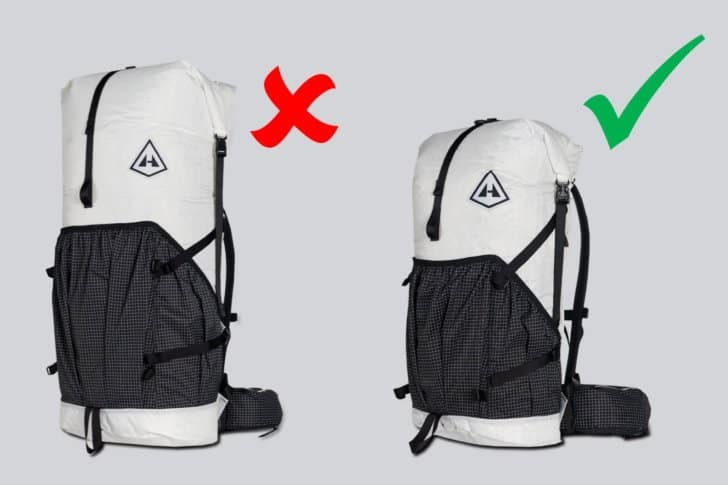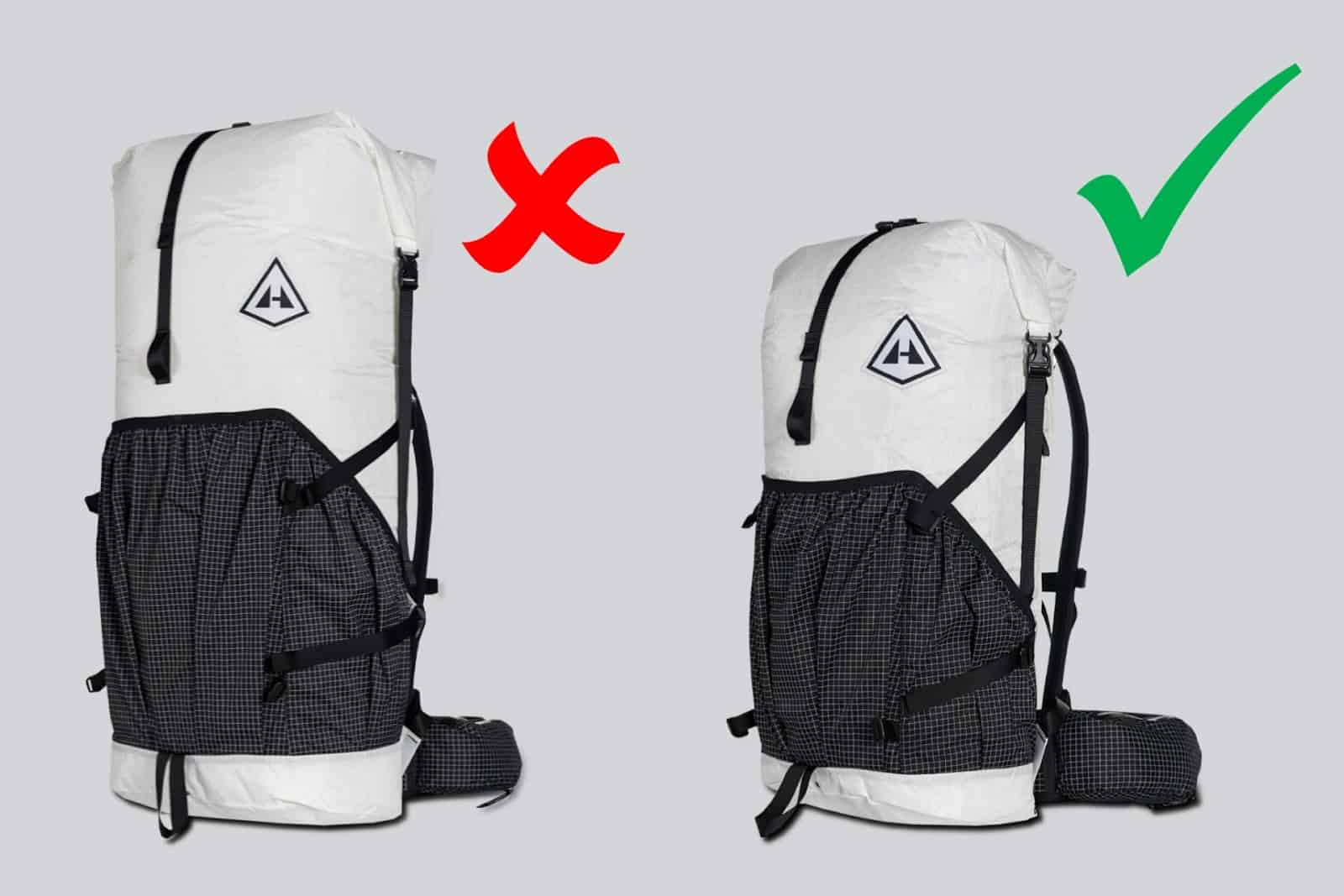Introduction
Internet pundits often insist that new lightweight backpackers should buy a pack last, so that it will hold all their new gear and a week’s worth of food. Sometimes the advice is to buy the pack first, a little larger in volume than the backpacker thinks they’ll need.
But both approaches can misfire, and I think there’s a better way.

The first purchase for transitioning trekkers should be a backpack that fits well and holds 50 liters (3,000 cubic inches) or less. Then they should buy and carry only as much gear, food, and water as fits inside, because they’ll always fill the space available. It took me three tries to figure this out the hard way.
Stumbling into Lightweight Backpacking

From the mid 1960s to the early 1980s, I backpacked with large external frame packs. Books and friends told me to buy the biggest volume hauler that fit, because you never knew what you might need to take. Catalogs and ads convinced consumers to buy a monster pack now in order to climb Mount Everest someday.
Of course, I always crammed those packs full, and frequently strapped more to the outside. I commonly carried 40 pounds (18 kg) for a two-night trip, and 55 pounds (25 kg) or more for Pacific Crest Trail sections. I was young and strong, but still couldn’t wait to dump my pack at all-too-frequent rest stops.
Then in the early 1980s a mainstream lightweight backpacking revolution started. Eventually I bought a low volume 2-pound (0.9 kilogram) internal frame pack for weekend trips. Most of my old equipment wouldn’t fit, which forced me to buy smaller and lighter gear and to carry less crap.
At last I could hike longer distances without suffering nearly as much. I actually enjoyed backpacking for several years, until a good friend introduced me to whitewater rafting.
Big Boat, Small Boat, Bigger boat
Most rafts can haul enormous piles of gear for overnight trips – and I did. But I also had to arrive a day early to inflate the boat, attach the frame, load the gear, and tie it all down with dozens of straps. And at each river camp I spent more hours unloading and reloading.
Then one evening at a live charity auction (with beer), I spontaneously bought a small cataraft that could carry me, my personal gear, and not much more. I could rig that boat in less time than it took to inflate most rafts. The cataraft’s small size and weight made it a joy to row down the river. And I schlepped a lot less stuff in camp.
Then I got married, bought a bigger raft, and hauled even bigger piles of gear. But I secretly longed for backpacking-style river trips, where each person brought just one large dry bag of equipment and food. Backpacking alone started looking better.
Third Time’s the Charm

By the time my 1980s lightweight backpacking gear wore out, the outdoor industry had reverted to 5 pound (2.3 kilogram) tents, packs, sleeping bags, and boots. My base pack weight jumped to 25 pounds (11 kilograms) and backpacking became a rarely-repeated sufferfest again.
But in 1993 I stumbled across Ray Jardine’s “The PCT Hiker’s Handbook,” and it blew my mind. Could I really backpack without hurting so much? I dropped weight piece by piece without downsizing my pack. I still carried too much gear “just in case,” and ultralight running shoes resulted in ultra-large blisters. It wasn’t until I bought a much smaller pack, which forced me to ditch unnecessary stuff again, that I got my base weight below 15 pounds. That was about 17 years ago. I think I’ve learned the lesson this time.
The Universe is Expanding?
An old rule of thumb says you’ll always fill the space available. This is true for garages, hard drives, and backpacks. So what happens when an enlightening trekker buys a smaller pack last? Until then, they keep using their old high-volume pack, they haul too much stuff, and they continue suffering. After spending big bucks on new gear, they could easily decide that lightweight backpacking is nonsense and give up.
If a lightweight convert buys a new pack first, “a little larger than needed,” then to be safe they’ll estimate too high, carry too much, and won’t be happy.
The American way is that bigger is better. Yet bigger backpacks are almost always heavier. Bigger means you’ll carry more stuff, which makes your load heavier. Bigger means there’s more fabric, seams, and straps to wear out, snag, leak, etc. And bigger is usually more expensive.
Better Advice
The first purchase for transitioning backpackers should be the smallest backpack that fits well and holds a downsized weekend load. For most trekkers that’s 50 liters (3,000 cubic inches) or smaller.
My 50-liter Hyperlite Mountain Gear Windrider 2400 fits me better than any pack I’ve owned or tried. I’ve used it to comfortably carry up to 33 pounds (15 kilograms) of gear, food, and water at the start of eight-day trips. And I’m not SUL or even UL – my base pack weight is about 13 pounds (6 kilograms).

Yet multiple reviewers claim that this pack is just big enough for weekend trips. They insist on recommending packs of 60 liters (3,700 cubic inches) or larger, especially since the 65-liter (4,000 cubic inch) Windrider 3400 weighs “only” 1.8 ounces (51 grams) more.
Start Small
The reality is you don’t need a bigger pack unless you plan to hike and camp in cold, snowy weather for many days, or carry a bunch of specialized gear like packrafts or climbing racks. Even if you do – why not buy a smaller pack first, carry less, and suffer less for most trips? If you need to carry more gear for special trips, you could downsize other equipment to make room, and hike even lighter most of the time. Or you could strap gear on. Or you could buy, borrow, or rent a larger pack.
But start small – 50 liters (3,000 cubic inches) or less. Because you’ll always fill the space available.
Note: Some backpack makers advertise just the main pack bag volume, others include the pockets. I included pockets for this post.
DISCLOSURE (Updated April 9, 2024)
- Product mentions in this article are made by the author with no compensation in return. In addition, Backpacking Light does not accept compensation or donated/discounted products in exchange for product mentions or placements in editorial coverage. Some (but not all) of the links in this review may be affiliate links. If you click on one of these links and visit one of our affiliate partners (usually a retailer site), and subsequently place an order with that retailer, we receive a commission on your entire order, which varies between 3% and 15% of the purchase price. Affiliate commissions represent less than 15% of Backpacking Light's gross revenue. More than 70% of our revenue comes from Membership Fees. So if you'd really like to support our work, don't buy gear you don't need - support our consumer advocacy work and become a Member instead. Learn more about affiliate commissions, influencer marketing, and our consumer advocacy work by reading our article Stop wasting money on gear.




Home › Forums › First, Buy a Smaller Pack